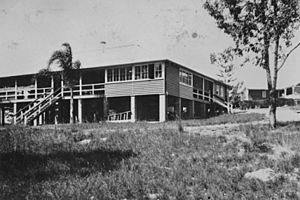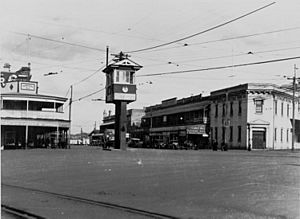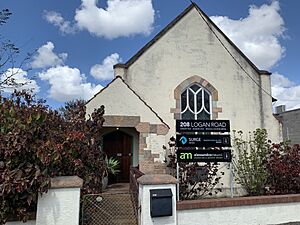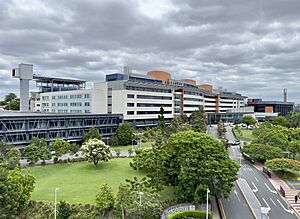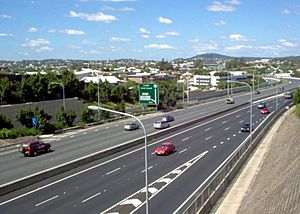Woolloongabba facts for kids
Quick facts for kids WoolloongabbaBrisbane, Queensland |
|||||||||||||||
|---|---|---|---|---|---|---|---|---|---|---|---|---|---|---|---|

Former post office on Stanley Street in Woolloongabba
|
|||||||||||||||
| Population | 8,687 (2021 census) | ||||||||||||||
| • Density | 3,470/km2 (9,000/sq mi) | ||||||||||||||
| Postcode(s) | 4102 | ||||||||||||||
| Area | 2.5 km2 (1.0 sq mi) | ||||||||||||||
| Time zone | AEST (UTC+10:00) | ||||||||||||||
| Location | 3.0 km (2 mi) SSE of Brisbane CBD | ||||||||||||||
| LGA(s) | City of Brisbane (The Gabba Ward) |
||||||||||||||
| State electorate(s) | South Brisbane | ||||||||||||||
| Federal Division(s) | Griffith | ||||||||||||||
|
|||||||||||||||
Woolloongabba is a lively suburb located just south of Brisbane city in Queensland, Australia. It's a busy place, well-known for its famous sports ground, "the Gabba." In 2021, about 8,687 people called Woolloongabba home.
Contents
Exploring Woolloongabba
Woolloongabba is about 3 kilometers (1.9 miles) south of Brisbane's main post office. It's easy to get to by road. This suburb is home to two very important places: the Brisbane Cricket Ground, often called 'the Gabba,' and the Princess Alexandra Hospital.
Many major roads cross through Woolloongabba, including the Pacific Motorway, Logan Road, and Ipswich Road.
There's a smaller area within Woolloongabba called Buranda, located in the south. The name Buranda comes from Aboriginal words meaning wind and place.
The Cleveland railway line also runs through the suburb. You can catch a train at Buranda railway station.
A Journey Through Time: Woolloongabba's History
The name Woolloongabba has an interesting past. Experts aren't completely sure, but it might mean 'whirling waters' or 'fight talk place' in Aboriginal languages.
For a long time, this area was low and swampy. People even called it the One Mile Swamp until the early 1890s!
Hospitals and Care
The land where the Princess Alexandra Hospital stands today has a long history of helping people. It started in 1893 as the Diamantina Orphanage. Over the years, it changed names several times, becoming a hospital for chronic diseases, then an auxiliary hospital, and finally the Princess Alexandra Hospital in 1960. This last name change happened when Princess Alexandra visited Brisbane.
Trains, Trams, and Trolleybuses
Woolloongabba has played a big part in Brisbane's transport history. From 1884 to 1969, the main train depot for lines south of the Brisbane River was located here. Trains from this depot had to cross busy roads, which caused traffic delays.
Horse-drawn trams served the suburb from 1885 to 1897. These were later replaced by electric trams, which stopped running in 1969. Most of Brisbane's trolleybus routes also passed through Woolloongabba from 1953 to 1969.
The Woolloongabba Fiveways was a very complex intersection where several major roads, tram lines, and railway lines met. A signalman controlled the trams, and a flagman guided the trains safely across.
From 1927 to 1969, the biggest tram depot in Brisbane was on Ipswich Road. Today, a shopping center stands on that spot.
Schools and Learning
Woolloongabba Mixed State School first opened its doors in 1884. It later split into separate schools for boys and girls. These schools eventually moved and became part of Dutton Park State School.
In 1893, a special school for blind, deaf, and mute students opened on Cornwall Street. Later, a separate school for blind students, Narbethong School for the Blind, was established in Buranda in 1963. This school later moved and is now Narbethong State Special School. Deaf students continued at the Cornwall Street school until it closed in 1988.
Buranda Girls and Infants State School opened in 1918, followed by Buranda Boys School in 1920. These schools eventually combined to form Buranda State School.
Churches and Community Places
The foundation stone for the Nazareth Lutheran Church was laid in 1895. This beautiful brick church, built in a Gothic design, opened in 1896.
St Luke the Evangelist's Catholic Church was built in the Spanish Mission style and opened in 1937. It was damaged in a hail storm in 2014 but has since been beautifully restored.
The Brisbane Spiritual Alliance Church opened in 1938. It was built thanks to a generous gift from George and Mary Coxon.
St Luke's Catholic Primary School opened in 1949 next to the church. It provided education for students until it closed in 1977.
In 2013, the Vulture Street Baptist Church moved to Woolloongabba and became known as Church@TheGabba.
Coca-Cola's First Australian Home
Did you know that the first Coca-Cola bottling plant in Australia was built in Woolloongabba in 1942? It was first made to supply American soldiers during World War II, but soon started making drinks for Australians too!
Who Lives in Woolloongabba?
In 2021, Woolloongabba had a population of 8,687 people. Many people from different countries call Woolloongabba home. In 2016, about 51.3% of residents were born in Australia. Other common birthplaces included China, New Zealand, England, South Korea, and India.
Most people (59.2%) spoke only English at home. Other languages spoken included Mandarin, Vietnamese, Korean, and Spanish. When it came to religion, many people said they had no religion (42.2%), while 15.2% were Catholic.
Buildings with a Story: Heritage Sites
Woolloongabba has many buildings and places that are listed on the Queensland Heritage Register. This means they are important parts of history and are protected. Some of these include:
- The Princess Theatre
- The Norman Hotel
- The Broadway Hotel
- The former Woolloongabba Police Station
- The Woolloongabba Air Raid Shelter
- St Luke's Catholic Church
- Nazareth Lutheran Church
Learning in Woolloongabba: Schools
- Buranda State School is a government primary school for students from Prep to Year 6. It's located on Cowley Street.
- Narbethong State Special School is a special primary and secondary school on Salisbury Street. It helps students who have impaired vision.
While there isn't a mainstream government high school directly in Woolloongabba, students can attend nearby schools like Brisbane State High School in South Brisbane or Coorparoo Secondary College in Coorparoo. A new school, Brisbane South State Secondary College, is also opening nearby in Dutton Park.
Important Places and Services
The Princess Alexandra Hospital (PA Hospital) is a very important public hospital. It provides care for adults in many different medical areas, including trauma and organ transplants. It also has an emergency department for urgent medical needs.
The main office for the Queensland Justices Association is also located in Woolloongabba.
Places to Worship
Woolloongabba is home to many different places of worship, showing the diverse community that lives there. These include:
- Serbian Orthodox Church of Saint Nicholas
- Holy Trinity Anglican Church
- Finnish Lutheran Church
- Holy Annunciation Orthodox Church
- Protection of the Mother of God Ukrainian Catholic Church
- New Apostolic Church
- Darul Uloom Islamic Academy of Brisbane
- South Brisbane Seventh-day Adventist Church
- St Luke's Catholic Church
- Nazareth Lutheran Church
Sports and Fun: The Gabba!
The suburb is famous for the Brisbane Cricket Ground, usually just called "the Gabba." This huge stadium is a popular place for cricket matches and Australian Rules Football (AFL) games.
Cool Spots to Visit
The Norman Hotel is a well-known local landmark. It has been serving customers since 1890, making it a place with a lot of history!
Getting Around Woolloongabba
The Pacific Motorway runs right through Woolloongabba, making it easy to travel by car. There's also an entrance to the Clem Jones Tunnel on Ipswich Road.
Public Transport Options
- Trains: You can catch a train at Park Road railway station and Buranda railway station.
- Buses: The South-East Busway has stops at Woolloongabba Busway Station and Buranda Busway station. The fast Maroon CityGlider bus service also stops here.
Taxis
Woolloongabba also has a major taxi depot, so it's easy to find a taxi if you need one.



